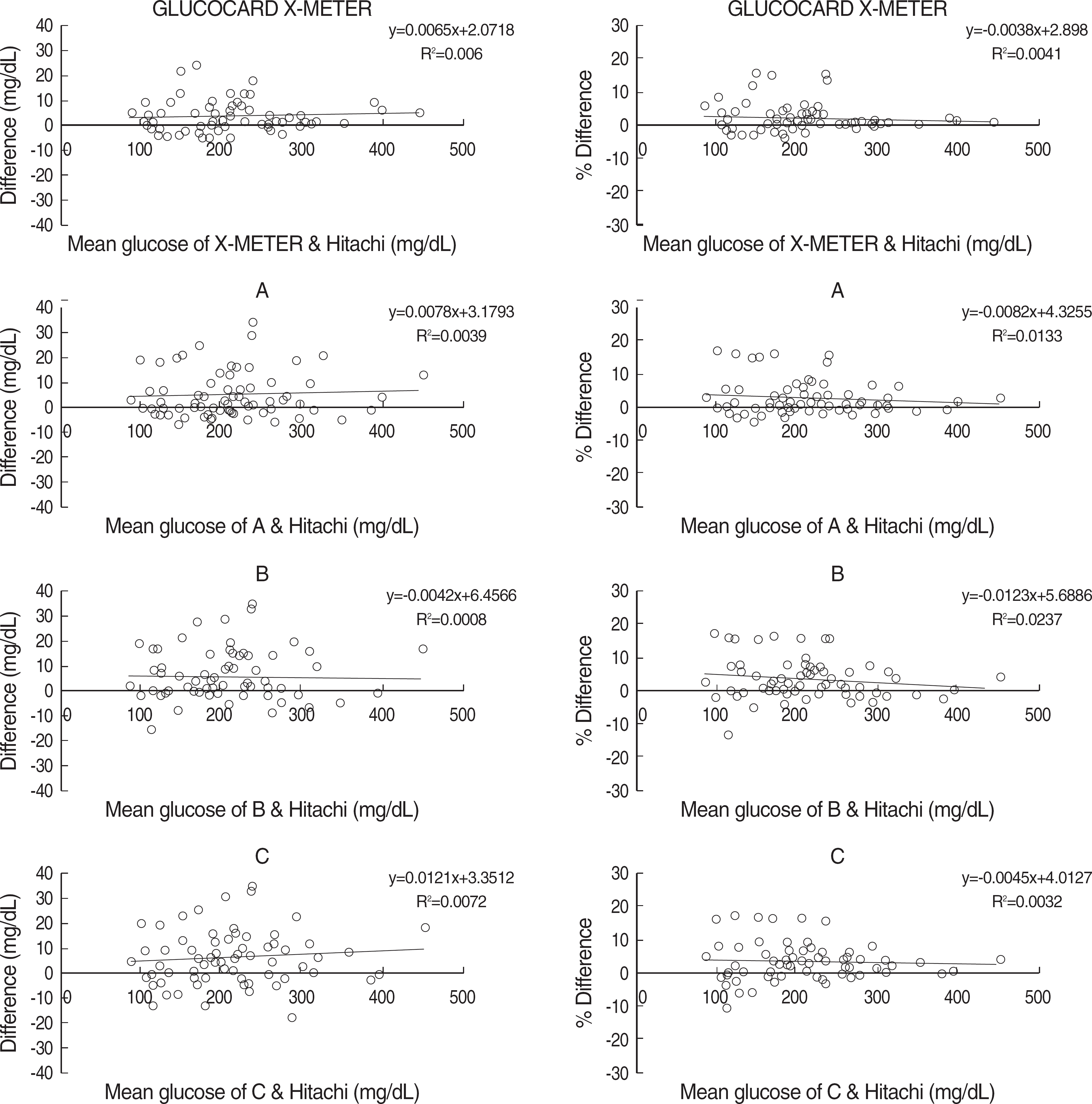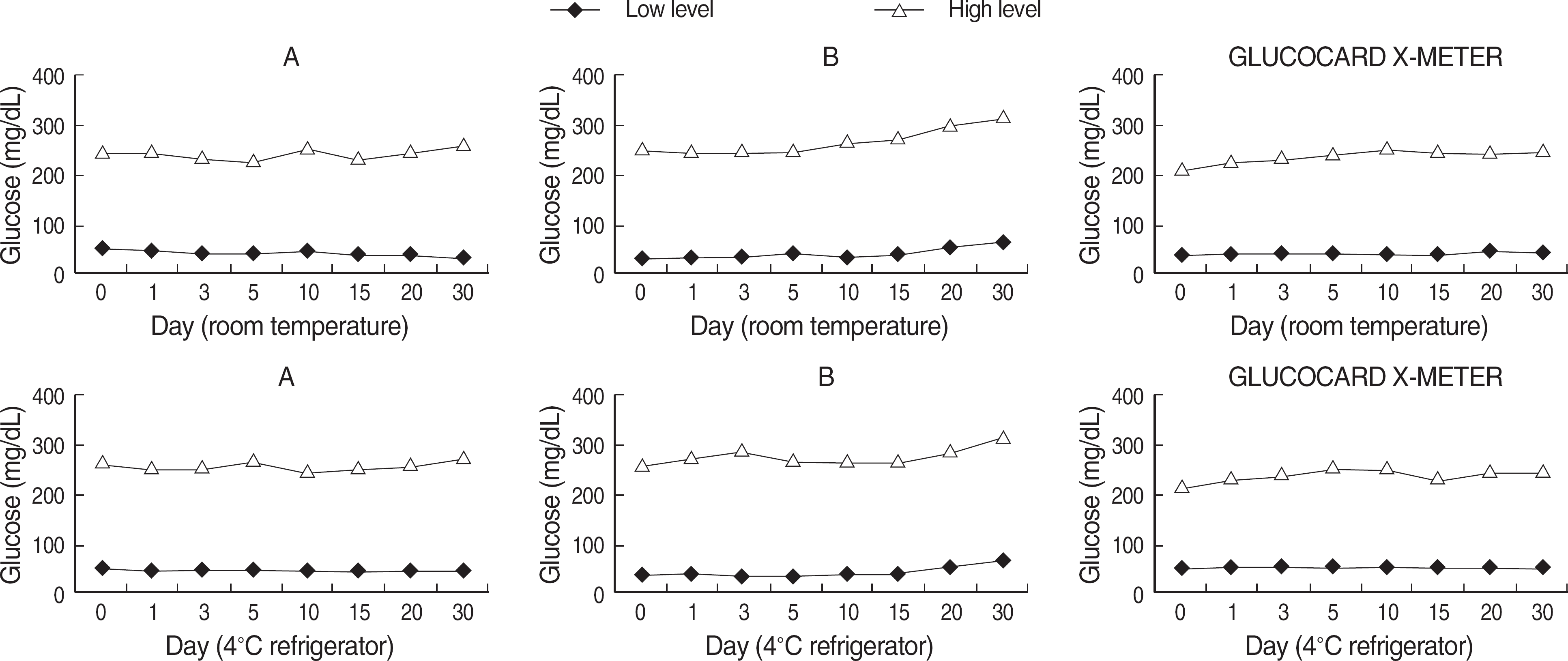Abstract
Background
Point-of-care testing (POCT) glucometers are increasingly being used for making important therapeutic decisions and managing diabetes. We examined the analytical performance of GLUCOCARD X-METER (ARKRAY Global Business Inc., Japan) against three other glucometers and a reference laboratory method.
Methods
We evaluated the analytical performance of GLUCOCARD X-METER in comparison with three other glucometers. Studies on precision, linearity, the analysis time, and effects of hematocrit and temperature were carried out and the results were compared with those of the laboratory reference method (hexokinase method by Hitachi 760, Hitachi Co., Japan).
Results
GLUCOCARD X-METER showed a good linearity and within-run and total-run precision. Comparison between each glucometer and the Hitachi 7600 showed a good correlation. Although differences with the reference method were within an allowable range, all glucometers showed variable bias. Application of an insufficient amount of blood could produce some changes in test results. Changes in hematocrit were found to cause overestimation or underestimation of glucose values. For some test strips, the results were affected by prolonged exposure to room temperature or 4°C refrigerator.
Conclusions
GLUCOCARD X-METER showed a good analytical performance in linearity, precision, and comparison. The effect of hematocrit, sample volume, and storage condition for test strips were noted and glucometers had variable deviations to both directions from laboratory reference values (<20%). The GLUCOCARD X-METER provided rapid and reliable measurements of blood glucose. It could be appropriate for monitoring blood glucose values in diabetic patients.
REFERENCES
1.Zimmet P., Alberti KG., Shaw J. Global and societal implications of the diabetes epidemic. Nature. 2001. 414:782–7.

2.Kim MH., Kim MK., Choi BY., Shin YJ. Educational disparities in the metabolic syndrome in a rapidly changing society–the case of South Korea. Int J Epidemiol. 2005. 34:1266–73.

3.Cho NH. Diabetes Epidemiology in Korean. J Korean Diabet Assoc. 2001. 25:1–10. (조남한. 한국인 당뇨병의 역학. 당뇨병 2001;25: 1-10.).
4.Korea National Statistical Office, Annual report on the cause of death statistics (Based on vital registration). 2006. (통계청, 사망원인통계연보 2006.).
5.Kim EJ, Min HK, editors. , eds.Diabetics. Seoul: Korea Medical Book Company;2005. p. 1. (김응진, 민헌기등. 당뇨병학: 고려의학 2005 1).
6.Parchman ML., Pugh JA., Noel PH., Larme AC. Continuity of care, self-management behaviors, and glucose control in patients with type 2 diabetes. Med Care. 2002. 40:137–44.

7.Clinical and Laboratory Standards Institute. Evaluation of the linearity of quantitative measurement procedures: A statistical approach; Approved guideline. Document EP6-A. Wayne, PA: Clinical and Laboratory Standards Institute;2003. p. 23.
8.Clinical and Laboratory Standards Institute. Evaluation of precision performance of quantitative measurement methods; Approved Guide-line-2nd edi. Document EP5-A2. Wayne, PA: Clinical and Laboratory Standards Institute;2004. p. 24.
9.Intensive blood-glucose control with sulphonylureas or insulin compared with conventional treatment and risk of complications in patients with type 2 diabetes (UKPDS 33). UK Prospective Diabetes Study (UKPDS) Group. Lancet. 1998. 352:837–53.
10.Amin R., Ross K., Acerini CL., Edge JA., Warner J., Dunger DB. Hypoglycemia prevalence in prepubertal children with type 1 diabetes on standard insulin regimen: use of continuous glucose monitoring system. Diabetes Care. 2003. 26:662–7.

11.The effect of intensive treatment of diabetes on the development and progression of long-term complications in insulin-dependent diabetes mellitus. The Diabetes Control and Complications Trial Research Group. N Engl J Med. 1993. 329:977–86.
12.Farmer A., Wade A., Goyder E., Yudkin P., French D., Craven A, et al. Impact of self monitoring of blood glucose in the management of patients with non-insulin treated diabetes: open parallel group randomised trial. BMJ. 2007. 335:132.

13.Peel E., Parry O., Douglas M., Lawton J. Blood glucose self-monitoring in non-insulin-treated type 2 diabetes: a qualitative study of patients' perspectives. Br J Gen Pract. 2004. 54:183–8.
14.Guerci B., Drouin P., Grange V., Bougneres P., Fontaine P., Kerlan V, et al. Self-monitoring of blood glucose significantly improves metabolic control in patients with type 2 diabetes mellitus: the Auto-Surveillance Intervention Active (ASIA) study. Diabetes Metab. 2003. 29:587–94.

15.Kim JW, Park HS, editors. Point of care test-Theory and practice. Seoul: Korea Medical Book Company;2000. (김종원 및 박효순. 현장검사-이론과 실제. 서울: 고려의학 2000.).
17.Kost GJ., Nguyen TH., Tang Z. Whole-blood glucose and lactate. Trilayer biosensors, drug interference, metabolism, and practice guidelines. Arch Pathol Lab Med. 2000. 124:1128–34.
18.Clinical and Laboratory Standards Institute. Point-of-Care blood glucose testing in acute and chronic care facilities; Approved Guideline-2nd ed. Document C30-A2. Wayne, PA: Clinical and Laboratory Standards Institute;2002. p. 22.
19.International Organization for Standardization: ISO 15197, Geneva 2003.
20.Johnson RN., Baker JR. Accuracy of devices used for self-monitoring of blood glucose. Ann Clin Biochem. 1998. 35:68–74.

21.Johnson RN., Baker JR. Error detection and measurement in glucose monitors. Clin Chim Acta. 2001. 307:61–7.

22.Yared Z., Aljaberi K., Renouf N., Yale JF. The effect of blood sample volume on 11 glucose monitoring systems. Diabetes Care. 2005. 28:1836–7.

23.Haller MJ., Shuster JJ., Schatz D., Melker RJ. Adverse impact of temperature and humidity on blood glucose monitoring reliability: a pilot study. Diabetes Technol Ther. 2007. 9:1–9.

24.Bamberg R., Schulman K., MacKenzie M., Moore J., Olchesky S. Effect of adverse storage conditions on performance of glucometer test strips. Clin Lab Sci. 2005. 18:203–9.
Fig. 1.
Linearity of glucose concentrations measured by the 4 glucometers, GLUCOCARD X-METER, A, B, and C.

Fig. 2.
Correlation of glucose concentrations measured by Hitachi 7600 vs. the 4 glucometers, GLUCOCARD X-METER, A, B,and C.

Fig. 3.
Bias plots of the difference (mg/dL) and % difference against the means between the glucometers, GLUCOCARD X-METER, A, B, and C, and Hitachi 7600.

Fig. 4.
Effect on glucose results of applying different sample volumes to respective test strips for the 3 glucometers, A, B, and GLUCOCARD X-METER.

Fig. 5.
Effect of exposure time at room temperature and 4°C refrigerator on the glucose concentrations measured by the 3 glucometers A, B, and GLUCOCARD X-METER.

Fig. 6.
Effect of hematocrit on glucose measurements by the 3 glucometers, A, B, and GLUCOCARD X-METER.

Table 1.
Precision of 4 glucometers including 2 different strip Lot. numbers in GLUCOCARD X-METER at 3 glucose concentrations




 PDF
PDF ePub
ePub Citation
Citation Print
Print


 XML Download
XML Download